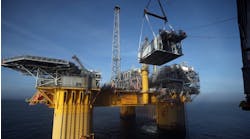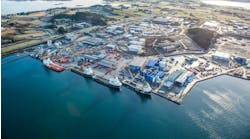SWEDEN Computer-Aided Vessel Design: Interfaces help speed up hull classification procedure
Ship design software specialist Tribon Solutions aims to improve communication between users of its programs and classification societies. Recently, it introduced interfaces between Tribon MI Version 3, ABS' SafeHull, and Lloyd's Register's RulesCalc systems. The interfaces are used to support a direct classification check of the hull cross-section.
Tribon M1Basic Design allows a 3D model to be created either of the basic steel structure of the whole ship or alternatively just the mid-body part. Assuming that the user has access to the classification software in his PC, he or she can then call that software at any time to obtain an immediate classification assessment of the proposed design. This is achieved through an automatic export function which extracts the cross-section geometry and property for all plates and stiffeners at a chosen section, then transfers them into the classification software. Subsequently, the classification software will relay the result of the analysis back to Tribon - should the designer so wish, the structure can then be updated automatically with the new proposed dimensions. According to Tribon, the key benefits of this initiative include:
- Faster classification rules check of multiple design alternatives
- Risk of human errors minimized, since the systems work with common data.
Tribon plans to introduce a further series of interfaces that will eventually cover all aspects of hull structure classification, including support for the transfer of complete 3D structures for design optimization.
Maintenance aid
A separate initiative involving Tribon is the Optimal Maintenance of Ships in Europe (OPTIMISE) project, which is part-funded by the European Commission through the Esprit program. The project's main aim is to develop new ship condition inspection techniques as well as supporting software. The results should enable vessel operators to determine or predict a vessel's condition at an early stage, thereby helping to reduce overall inspection costs. Furthermore, by aiding planning and undertaking of preventive maintenance, it should improve overall safety of vessel operations.
As part of OPTIMISE, the Product Information Model within Tribon's Condition Manager software has been extended and linked to ship condition data. Ideally, the initial data needed for operation of the vessel could be extracted from the Product Information Model formed and used by the shipyard during construction. The Condition Manager will offer interfaces to traditional inspection methods as well as to the robotized measuring device developed for this project.
For more information contact Magnus Feldt, Tribon Solutions: tel +46 40 668 0300, fax +46 40 668 0301, E-mail: [email protected].


